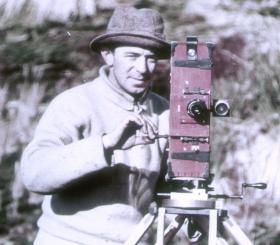Introduction
It is Frank Hurley’s photographs of the frozen continent of Antarctica that we remember best —soaring ice shelves, waddles of cute penguins and balaclava clad men. Far less known are his evocative photographs of soldiers, war-torn landscapes and military operations in northern Europe and Palestine taken during the catastrophic First World War. Hurley spent only seven months at the front, but the images he captured of the war featured in exhibitions in London, Sydney and Melbourne. And it was those photographs, many of which became iconic, that made his name.
Some of Hurley’s Canadian counterparts on the front were experimenting with using two or more negatives to make a single print. Hurley embraced the practice: it seemed to him catch the drama and theatre and horror of war. But it was controversial: was he manipulating the truth? Or using artistic licence to tell the truth of war?
James Francis (Frank) Hurley was born in Glebe, Sydney, on 15 October 1885. At the age of thirteen, he ran away from Glebe Public School after a fight with his teacher. He stowed away on a goods train that took him to Lithgow, where he got a job at the Esk Bank Ironworks. A friendship with the foreman, ‘Big Bill’, sparked his interest in photography. He bought a Kodak ‘box brownie’ camera for 15 shillings, paying it off at one shilling a week. And so began the brilliant career of the photographer, cinematographer and adventurer, Frank Hurley.
Title image: 'Infantry moving forward to take over the front line at evening'. From an Exhibition of war photographs taken by Capt. F. Hurley, August 1917- August 1918

